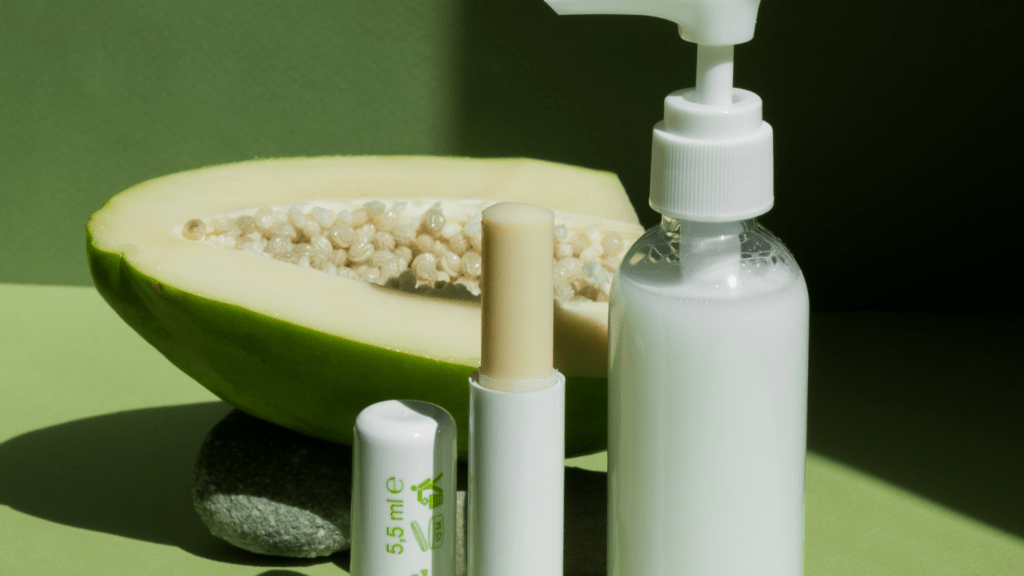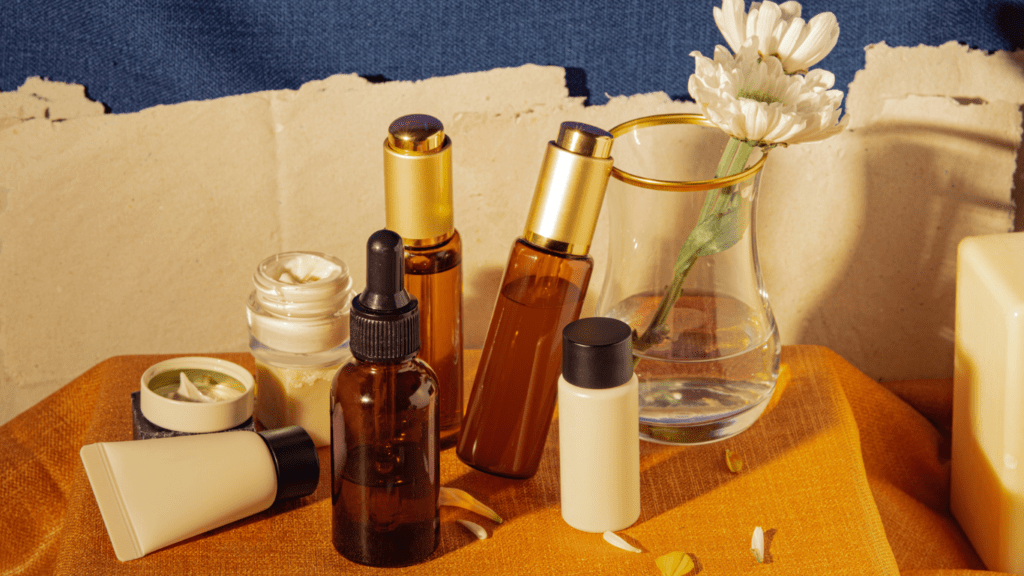Understanding Natural Beauty Products
In this section, I’ll delve into what makes a beauty product “natural” and explore its distinct benefits.
What Defines Natural Beauty Products?
Natural beauty products contain ingredients derived from nature, like:
- plants
- minerals
- animal-derived items such as beeswax
These products exclude synthetic chemicals, artificial fragrances, and preservatives that can irritate the skin.
Certifications, like USDA Organic or Ecocert, often mark trustworthy natural products.
For example, a USDA Organic-certified moisturizer ensures it’s made with at least 95% organic ingredients. Always check ingredient lists to validate the natural claims of beauty items.
Benefits of Using Natural Beauty Ingredients
- Using natural beauty ingredients offers several advantages.
- Plant-based ingredients, like aloe vera and chamomile, provide soothing effects without causing allergic reactions.
- Natural oils, such as argan and jojoba, mimic the skin’s natural sebum, promoting better moisture retention.
- Products devoid of synthetic additives reduce the risk of long-term health issues.
- With fewer preservatives and chemicals, these products help maintain eco-friendly practices.
- When switching to an all-natural beauty routine, these benefits foster healthier skin and a more sustainable environment.
Evaluating Your Current Beauty Routine
Transitioning to an all-natural beauty routine begins with evaluating your current products. Understanding what you are using now will help you make informed decisions.
Identifying Harmful Ingredients in Your Products
Check the labels on your beauty products. Look for ingredients like parabens, sulfates, and synthetic fragrances.
Parabens (e.g., methylparaben and butylparaben) disrupt hormonal balance. Sulfates (e.g., sodium lauryl sulfate) strip natural oils from the skin. Synthetic fragrances often contain phthalates, which are linked to various health issues.
The Impact of Conventional Beauty Products on Health
Conventional beauty products affect health over time. Parabens and phthalates impact hormone regulation. Sulfates cause skin irritation and dryness. Synthetic chemicals in cosmetics have links to allergies and more serious health conditions. Understanding these impacts clarifies the benefits of switching to natural products.
Planning Your Transition to a Natural Beauty Routine
Switching to an all-natural beauty routine requires careful planning. Establishing clear goals and timelines and adopting a gradual approach will ensure lasting success.
Setting Realistic Goals and Timelines
Set achievable goals when transitioning to a natural beauty routine. Start by identifying key areas needing change, like skincare or haircare products.
For instance, if switching from chemical-laden face cleansers to natural ones, focus solely on facial care for the first month. Divide the overall transition into manageable phases, each spanning 3-4 weeks, to accommodate adjustments.
Document target deadlines using a planner; ensure each timeline aligns with product usage patterns to avoid overlap and redundancy.
Tips for a Gradual Transition
Ease into the natural beauty journey by swapping one product at a time. Begin with products in significant contact with skin, like body lotions or face creams, and replace synthetic versions with natural alternatives. Conduct patch tests to check for allergies before fully integrating new items.
Gradually shift to natural shampoo and conditioner, allowing your scalp to adapt. Explore options with familiar ingredients, such as coconut oil or shea butter, for smoother transitions. Join online communities or follow natural beauty forums to gain insights and recommendations tailored to your needs.
Essential Natural Products for Your Beauty Regimen

Choosing the right natural products ensures a smooth transition. Below are key categories to focus on first.
Cleansers and Moisturizers
Natural cleansers remove impurities without stripping away essential oils. Ingredients such as chamomile and green tea provide gentle cleansing, and rose water works well as a toner.
For moisturizing, look for products with shea butter, coconut oil, and jojoba oil. These ingredients hydrate skin effectively without clogging pores. Opt for creams that use aloe vera and essential oils to enhance skin elasticity.
Make-Up and Hair Care Products
Natural makeup minimizes skin irritation and promotes health. Consider foundations with minerals like zinc oxide, which offer UV protection. Lipsticks and blush made from fruit pigments provide vibrant color without synthetic dyes.
For hair care, shampoos and conditioners free from sulfates and parabens help maintain scalp health. Ingredients like argan oil and coconut milk nourish and strengthen hair, fostering natural shine and growth.
Maintaining Your New Natural Beauty Routine
Transitioning to an all-natural beauty routine requires ongoing attention and adjustment. Consistent monitoring and adaptation are crucial for maintaining the health of your skin and hair.
Monitoring Skin and Hair Health
Regularly check your skin and hair for any changes. Note any new reactions or irritations. Keep a journal to track your skin’s response to new products and ingredients. This helps identify what works best and what doesn’t.
Look for improvements in hydration, texture, and overall appearance. Healthy skin often appears more radiant, and healthy hair looks shinier and feels softer.
Adjusting Products and Practices as Needed
Switching to natural products might require adjustments. If a product causes irritation, stop using it and try another. Patch test new products before full application.
Modify your routine according to seasonal changes; for instance, opt for richer moisturizers in winter. Be patient since it might take time for your skin and hair to adapt and show improvements. Adapt practices based on your skin’s and hair’s evolving needs.
 Heather Smithkers - Innovative Eco-Author at Green Commerce Haven
Heather Smithkers is a creative and forward-thinking author at Green Commerce Haven, where she brings a unique perspective to the world of sustainability. With a flair for storytelling and a deep commitment to environmental advocacy, Heather crafts engaging content that resonates with eco-conscious readers. Her work delves into the latest trends in green startups, organic products, and sustainable living, offering fresh insights and practical advice. Heather’s innovative approach to writing helps demystify complex environmental topics, making them accessible and inspiring to a broad audience.
Heather Smithkers - Innovative Eco-Author at Green Commerce Haven
Heather Smithkers is a creative and forward-thinking author at Green Commerce Haven, where she brings a unique perspective to the world of sustainability. With a flair for storytelling and a deep commitment to environmental advocacy, Heather crafts engaging content that resonates with eco-conscious readers. Her work delves into the latest trends in green startups, organic products, and sustainable living, offering fresh insights and practical advice. Heather’s innovative approach to writing helps demystify complex environmental topics, making them accessible and inspiring to a broad audience.
